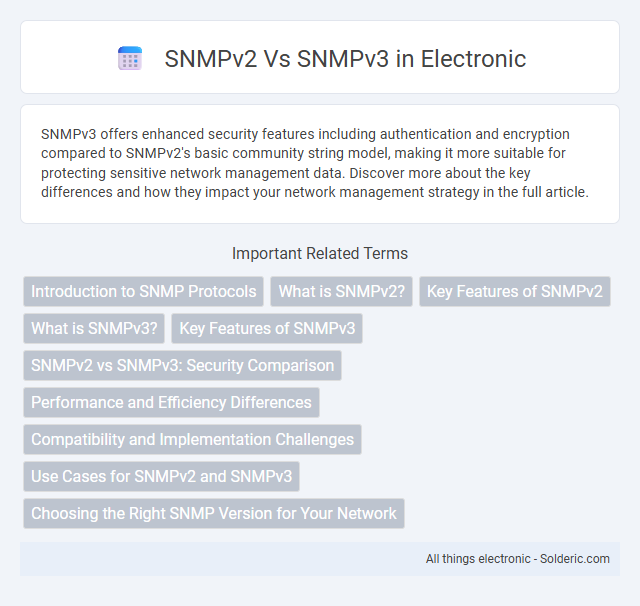SNMPv3 offers enhanced security features including authentication and encryption compared to SNMPv2's basic community string model, making it more suitable for protecting sensitive network management data. Discover more about the key differences and how they impact your network management strategy in the full article.
Comparison Table
| Feature | SNMPv2 | SNMPv3 |
|---|---|---|
| Security | Community-based, no encryption | Advanced: authentication, encryption, message integrity |
| Authentication | None or simple community strings | User-based Security Model (USM) with MD5/SHA |
| Privacy | Not supported | Supported via data encryption (AES/DES) |
| Access Control | Limited or none | View-based Access Control Model (VACM) |
| Protocol Version | SNMPv2c most common | Full SNMPv3 standard |
| Message Integrity | Not guaranteed | Ensured via HMAC |
| Use Case | Basic monitoring, low security needs | Secure network management, enterprise environments |
Introduction to SNMP Protocols
SNMPv2 improved upon the original SNMP by offering enhanced performance with bulk retrieval, providing more efficient network management data collection. SNMPv3 introduced significant security features, including authentication, encryption, and message integrity, addressing vulnerabilities inherent in earlier versions. Both protocols remain essential in network monitoring, with SNMPv3 favored for environments requiring robust security.
What is SNMPv2?
SNMPv2 (Simple Network Management Protocol version 2) is an enhanced version of SNMPv1 designed to improve network management by providing better error handling, more efficient data retrieval with bulk requests, and expanded protocol operations such as GetBulk and Inform messages. It supports community-based security, which lacks strong authentication and encryption, making it less secure compared to newer versions. SNMPv2 remains widely used for monitoring network devices due to its improved performance and functionality over SNMPv1 despite limited security features.
Key Features of SNMPv2
SNMPv2 offers enhanced performance with improved error handling and bulk data transfer capabilities, making network management more efficient. It supports GetBulk requests, enabling faster retrieval of large data sets, and introduces improved data types for better management of network devices. Your network benefits from these features through more reliable monitoring and reduced management traffic compared to SNMPv1.
What is SNMPv3?
SNMPv3 is the third version of the Simple Network Management Protocol designed to enhance network management security and interoperability. It introduces robust features such as message integrity, authentication, and encryption to protect management data from unauthorized access and tampering. SNMPv3 maintains compatibility with earlier versions while providing improved administration and user-based security models (USM) for scalable network monitoring.
Key Features of SNMPv3
SNMPv3 enhances network management with robust security features including user authentication, data integrity, and encryption, addressing vulnerabilities present in SNMPv2. It supports flexible user-based access control, ensuring that Your network data remains confidential and protected against unauthorized access. SNMPv3 also offers improved message processing and error handling, making it the preferred choice for secure and reliable network monitoring.
SNMPv2 vs SNMPv3: Security Comparison
SNMPv3 offers significant security improvements over SNMPv2, including robust authentication and encryption mechanisms that protect against unauthorized access and data interception. SNMPv2 primarily relies on community strings for access control, which are transmitted in clear text, making it vulnerable to eavesdropping and spoofing attacks. Enhanced user-based security models (USM) in SNMPv3 enable granular access control, message integrity, authentication, and confidentiality, ensuring a more secure network management environment.
Performance and Efficiency Differences
SNMPv2 offers faster performance due to its simpler protocol design and reduced security overhead, making it efficient for monitoring in low-security environments. SNMPv3 introduces enhanced security features such as encryption and authentication, which add processing overhead but significantly improve data integrity and confidentiality. Your choice between SNMPv2 and SNMPv3 should balance the need for efficient performance against the critical requirement for secure management in your network infrastructure.
Compatibility and Implementation Challenges
SNMPv2 offers broader compatibility with legacy systems, enabling easier integration into existing network infrastructures, but it lacks robust security features compared to SNMPv3. SNMPv3 introduces advanced security mechanisms such as authentication and encryption, yet implementation challenges arise due to increased complexity and the need for updated management tools. Your choice between SNMPv2 and SNMPv3 should consider both network compatibility requirements and resources available for secure deployment.
Use Cases for SNMPv2 and SNMPv3
SNMPv2 is commonly used in smaller or less security-critical networks where ease of implementation and compatibility with older devices are priorities, making it suitable for basic network monitoring and management tasks. SNMPv3 is preferred in environments requiring enhanced security features such as authentication, encryption, and access control, ideal for enterprise networks, data centers, and scenarios where sensitive data protection is essential. Organizations use SNMPv3 for compliance with security standards and secure remote management, while SNMPv2 remains in use for legacy support and less security-sensitive applications.
Choosing the Right SNMP Version for Your Network
Choosing between SNMPv2 and SNMPv3 depends on your network's security and functionality needs; SNMPv3 offers enhanced security features such as authentication and encryption, making it ideal for sensitive environments. SNMPv2 provides faster performance and improved error handling but lacks robust security protocols, suitable for less critical or internal networks. Assess your network's size, security requirements, and management goals to determine which SNMP version aligns best with Your operational priorities.
SNMPv2 vs SNMPv3 Infographic

 solderic.com
solderic.com